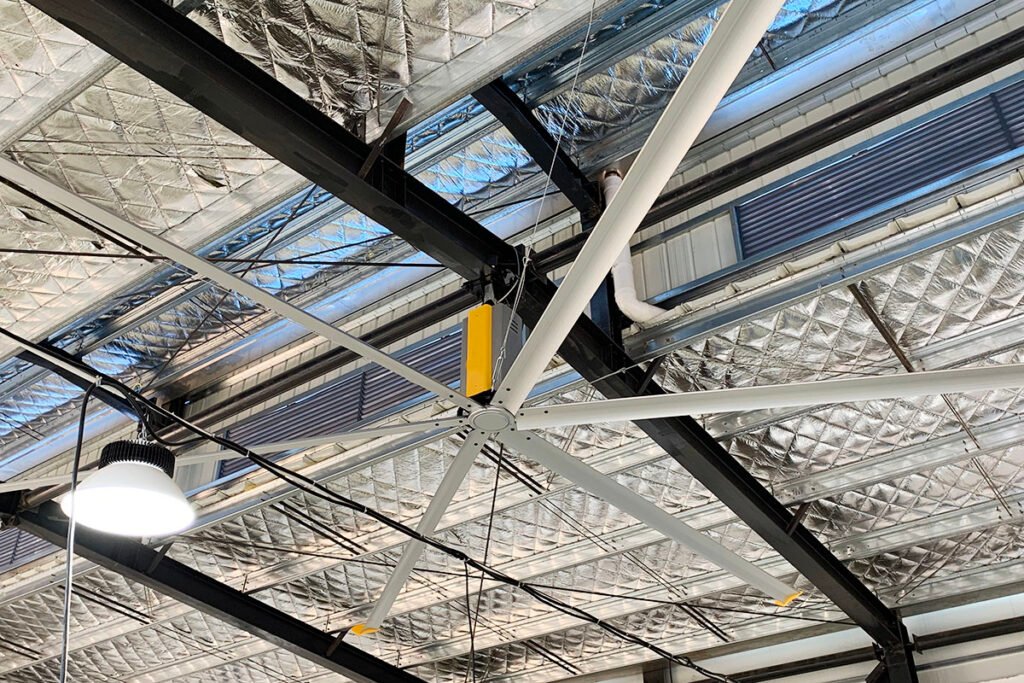
High Volume, Low Speed (HVLS) fans are recognized for their exceptional ventilation and cooling effects, particularly in large spaces with high ceilings. These industrial ceiling fans offer a range of benefits that enhance the overall environment and comfort level. Here’s a detailed look at the ventilation and cooling effects of HVLS large fans, incorporating insights from the provided sources:
Improved Air Circulation
HVLS fans are engineered to move significant volumes of air, ensuring effective circulation throughout the space. Their large blades, when rotating at low speeds, create a gentle breeze that can be felt across vast areas. This improved air circulation helps in reducing stagnant air, preventing the formation of hot and cold spots, and promoting a more comfortable and uniform environment.
Energy Efficiency
One of the standout features of HVLS fans is their energy efficiency. They consume less power compared to traditional high-speed fans or air conditioning systems. The large surface area of the blades and their slow-moving design allow for effective air movement with minimal energy consumption. This results in reduced energy costs and a lower environmental impact.
Noise Reduction
HVLS fans operate at low speeds, which significantly reduces the noise levels associated with their use. This makes them suitable for environments where noise is a concern, such as offices, schools, and libraries. The quiet operation allows for improved air circulation without the disturbance of excess noise.
Enhanced Ventilation
HVLS fans, particularly those from brands like MacroAir, are designed to enhance ventilation. They help remove stale air and odors by effectively circulating fresh air throughout the space. This is especially beneficial in areas with poor natural ventilation, such as warehouses or large commercial buildings, where HVLS fans can significantly improve air quality.
Temperature Regulation
HVLS fans contribute to temperature regulation by improving air movement. During warmer months, the airflow from the fans creates a cooling effect, making occupants feel more comfortable. In colder months, the fans can be set to run in reverse, pushing warm air trapped near the ceiling down to where it is needed. This dual functionality makes HVLS fans a versatile and year-round solution for temperature control.
Effective Cooling
The cooling effect of HVLS fans is not just about air movement; it’s also about how they interact with the space. HVLS fans can make a space feel several degrees cooler, according to some estimates. This is achieved by increasing circulation and decreasing humidity during the summer months. The large-scale rotation of the fans also helps to keep bugs and birds away, adding to the overall comfort and cleanliness of the area.
Space Saving
While HVLS fans are large in size, they are ceiling-mounted and do not take up valuable floor space. This maximizes the useable area in workshops or storage facilities, eliminating the need for floor fans and other smaller-scale cooling devices.
Comparative Performance
Studies, such as those found on ScienceDirect, have shown that HVLS fans cover larger areas with more uniform airflow compared to high-speed fans. They remain effective at increasing distances and provide a cooling effect that is comparable to, if not better than, traditional high-speed fans, especially in large spaces like dairy barns.
Conclusion
The ventilation and cooling effects of HVLS large fans make them an ideal choice for large spaces requiring efficient air movement and temperature control. Their energy efficiency, quiet operation, and ability to enhance ventilation and regulate temperature make them a cost-effective and environmentally friendly solution for both commercial and industrial applications. With the right selection and installation, HVLS fans can significantly improve the comfort and productivity of any large space.
